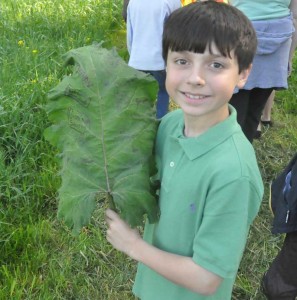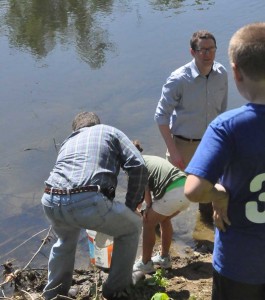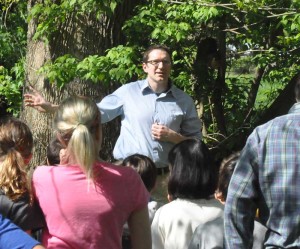Pocopson, Hillendale and Chadds Ford schools among 10 helping to repopulate local waters
By Mike McGann, Editor, UnionvilleTimes.com

Bryan Denmark, a fourth grade student at Pocopson Elementary School, displays a leaf signed by many of the students, which was released into the Brandywine Creek along with hundreds of tiny shad fry, Friday. Students from three local schools, Pocopson, Hillendale and Chadds Ford participated in the program, supervised by the Brandywine Conservancy.
POCOPSON — While there have been a myriad of fish tales told over the years, maybe one of the best ones is now being written by students from three local schools: helping to repopulate shad in the Brandywine Creek and throughout Christina River Basin.
Hundreds of students at Pocopson, Hillendale and Chadds Ford elementary schools carried fry — young shad — that the students helped to hatch earlier in the week in their classrooms and set them free in the Brandywine, Friday.
The young shad will grow and migrate downriver, ultimately ending up in the Atlantic Ocean. If everything goes right, and there are very literal barriers remaining, some of the same shad could return to the banks of Brandywine in about four years to spawn.
That’s the hope, according to Timothy Lucas, an Associate Planner with the Brandywine Conservancy, the local coordinators of the shad restocking, who was on hand to guide students from Pocopson Elementary as they released the tiny shad into the creek.

Parent volunteer Gary Barnett and Tim Lucas of Brandywine Conservancy help students release shad into the Brandywine.
The Pocopson students tracked down from their school, under the guidance of their teachers and some volunteer parents, and walked down to the banks of the creek just north of the Route 926 bridge.
The hangup? Dozens of old dams, many dating from more than a century ago when they were used to tap the Brandywine, Red Clay and White Clay creeks for power in the late 1800s. Without removing the dams — or creating alternate routes upstream, such as fish ladders — the shad will be unable to return to the Brandywine.
Lucas said he is hopeful that some of the dams will ultimately removed, but that it may take some work by the states of Pennsylvania and Delaware to make it happen, thanks to complicated ownership status — and some larger challenges, such as the dam that helps provide the city of Wilmington its drinking water.
Despite the challenges ahead, the students seemed to be very excited, five classes of fourth grade students from Pocopson — more than 100 students — spent the better part of the week keeping tabs on the fry, who hatched in the school’s science lab, after being delivered by Lucas early Monday morning. After hatching, the fry are tiny and barely visible to the naked eye. Students were able to get a better look, thanks to a microscope attached to a TV monitor in the lab — with two eyes, a translucent body and spine the primary features.

Timothy Lucas of the Brandywine Conservancy speaks to students from Pocopson Elementary School about the shad they just helped to release into the Brandywine Creek, Friday.
While adults carried the tiny fish to the creek in large containers, many students were able to get right to water’s edge and send the fry on their way. Others were able put leaves in the water — including a giant leaf with the names of many of the students participating Friday.
This is the second year Pocopson students participated — and in total 10 schools participated Friday, up from four in 2010. In addition to the three schools in the Unionville-Chadds Ford School District, St. Ann’s School, Tower Hill School and Wilmington Friends School, Upland Country Day School, Avon Grove Charter School, Holy Angels School and R. Elisabeth Maclary Elementary School participated this year.
The shad release is part of a larger project by the Brandywine Conservancy, working with the University of Delaware’s Water Resources Agency to return the shad to the Brandywine and other local water ways, in part to increase biological diversity in the basin; shad are a food source for numerous other species, which would likely see a population increase if shad were again plentiful in local waters.







How can I ( we ) help Mr Lucas I belong to Delco / Manning TU Does he do speaking engagements at trout clubs etc Thanks Brian
Hi Brian,
I’m betting Tim would love to hear from you — all of his contact information is on the Brandywine Conservancy Web site: http://www.brandywineconservancy.org Look under Contact Info and then Staff Directory.
Mike